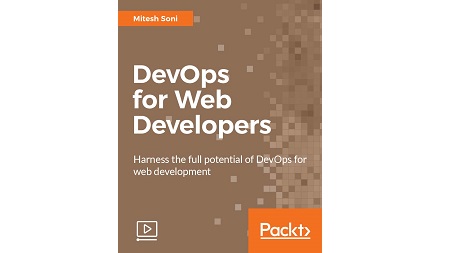
English | MP4 | AVC 1280×720 | AAC 44KHz 2ch | 3h 48m | 793 MB
Leverage DevOps to build and deploy modern web apps efficiently
This course shows you how to accelerate web development with DevOps. It starts by introducing you to the culture and collaboration that need to be promoted in order to use DevOps within your organization. You will learn why itis essential to build and deploy modern apps efficiently when embracing the DevOps methodology.
You will learn to use GitHub to push code and commit the changes using git. Moving on, you’ll understand the basics of configuration management and the architecture of DevOps. You’ll see how to take care of deploying the code into our new shiny servers. Then we’ll explore monitoring and varioussolutions to the range of problems we might face.
Finally, you’ll be able to develop, deploy, manage, and automate your complete web application on a cloud service.
What You Will Learn
- Understand the configuration management and architecture of Devops
- Find out how to deploy and continuous integration to new servers
- Monitor and explore varioussolutions to get on top of the problem
- Take advantage of the cloud solution using AWS-specific tools and services
- Explore and analyze the pros and cons of a Dockerized platform
- Automate the development and deployment of a web application on to a cloud services
Table of Contents
01 The Course Overview
02 Understanding the DevOps Movement
03 The DevOps Lifecycle
04 Tools and Technologies
05 An Overview of a Sample Java EE Application
06 Installing Jenkins and the Jenkins Dashboards
07 Configuring Java and Mavens in Jenkins to Build Job for a Java Application with Maven
08 Configuring and Authenticating Source Code on GitHub
09 Configuring Build Job and JUnit
10 The Dashboard View Plugin – Overview and Usage
11 Managing Nodes
12 Sending E-mail Notifications Based on buildstatus
13 Integrating Jenkins and Sonar
14 Creating Built-in Delivery Pipelines
15 Creating a Pipeline for Compiling and Executing Test Units
16 Using the Build Pipeline Plugin
17 Integrating the Deployment Operation
18 Getting Started with Chef
19 Overview of Hosted Chef
20 Installing and Configuring a Chef Workstation
21 Converging a Chef Node Using a Chef Workstation
22 Installing Software Packages Using Cookbooks
23 Creating a Role
24 Understanding the Difference Between Virtual Machines and Containers
25 Installing and Configuring Docker on CentOS
26 Creating Your First Docker Container
27 Understanding the Client-Server Architecture of Docker
28 Managing Containers
29 Creating a Docker Image from Docker file
30 Chef and Cloud Provisioning
31 Installing Knife Plugins for Amazon Web Services and Microsoft Azure
32 Creating and Configuring a Virtual Machine in Amazon EC2
33 Creating and Configuring a Virtual machine in Microsoft Azure
34 Docker Containers
35 Prerequisites – Deploying Our Application on a Remote Server
36 Deploying an Application in Docker Container
37 Deploying an Application in AWS
38 Deploying an Application in Microsoft Azure
39 Getting Started – Monitoring
40 Overview of Monitoring Tools and Techniques
41 Monitoring AWS Elastic Beanstalk
42 Monitoring Microsoft Azure Web App Service
43 Creating Build Jobs for End-to-end Automation
44 Configuring SSH Authentication Using a Key
45 Configuring the Build Pipeline for Build Job Orchestration
46 Executing the Pipeline for Application Deployment Automation
47 Hygieia – a DevOps Dashboard
Resolve the captcha to access the links!